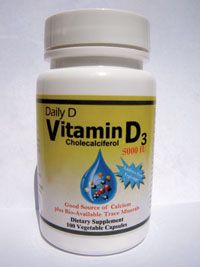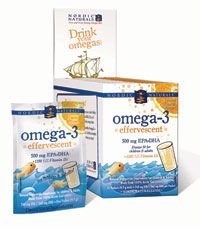Trends in 2010
Consumers are still buying supplements. This year, expect shoppers to continue focusing on immune health, gluten free, cognitive health, joint health, eye health, digestive health, and weight management. Below are a few ingredients the industry will be keeping its eye on.
Originally Published NO January/February 2010
Consumers are still buying supplements. This year, expect shoppers to continue focusing on immune health, gluten free, cognitive health, joint health, eye health, digestive health, and weight management. Below are a few ingredients the industry will be keeping its eye on.

Vitamin D
The "sunshine vitamin" will keep enjoying the spotlight this year. A wave of recent studies continue to tout the benefits of vitamin D, which has been linked to bone health, immune health, lower risk of several cancers, reduced heart attacks, and fewer falls by the elderly, among other things. Last year, the U.S. Department of Agriculture added more than 3000 vitamin D values for foods listed in its National Nutrition Database.
This year will spur more vitamin D research. In January, the National Institutes of Health began recruiting for a $20 million, five-year study that will examine whether vitamin D (approximately 2000 international units (IU)/day) and omega-3 (approximately 1 g/day) supplements can reduce the risk of developing cancer, heart disease, and stroke. The Vitamin D and Omega-3 Trial, also known as VITAL, will enroll 20,000 U.S. participants, including women older than 65 and men older than 60 without a prior history of cancer, heart disease, and stroke. In particular, it will focus heavily on African Americans (25% of the participants will be African American), who are often deficient in vitamin D because darker-pigmented skin generally doesn't produce as much vitamin D from sunlight.
Also expect recommended intake levels for vitamin D in the United States to increase in the near future. Already in 2008, the American Academy of Pediatrics doubled its daily vitamin D recommendation for infants and children to 400 IU/day. Last year, the Institute of Medicine's Food and Nutrition Board began reviewing research touting the benefits of higher levels of vitamin D to determine whether recommended intake levels should be raised. The committee's report is expected this May.

Omega-3
Consumers continue to flock to omega fatty acids for cardiovascular and cognitive health and a host of conditions such as mood disorders and age-related macular degeneration. In September, Forbes highlighted omega-3 in a cover story titled, "One Supplement That Works." According to Packaged Facts, the market for omega-3, omega-6, and omega-9 fatty acids may grow to $8 billion by 2012.
Numerous studies last year added to the positive reports. One study said that infants who consume omega-3–fortified formula may develop better problem-solving skills. Another study claimed that omega-3 may help enhance the joint-health effectiveness of glucosamine.
Industry is now pushing for higher recommended doses of omega-3. Among other organizations, the Global Organization for EPA and DHA Omega-3 (GOED) has petitioned the Institute of Medicine to set clear intake recommendations for DHA and EPA.
Probiotics
The European Food Safety Authority (EFSA) may have rejected one probiotic health claim after another, but that doesn't seem to have dampened the hopes of probiotic companies-and for good reason. Industry analysts forecast the probiotics market will continue growing at 12% compound annual growth rate, at least until 2013.
Probiotic manufacturers and functional foods and beverage companies are working together to include probiotics in a widening array of products. (Read this issue's cover story for more detail.)
EFSA's rejections, plus publicity surrounding Dannon's $35 million settlement last year over its probiotic product claims, may have darkened the skies a bit over probiotics. To ensure the efficacy of its products, the probiotics industry continues to stress the importance of condition-specific strains-and is working to hammer this message home to consumers.
"We're doing everything we can do to help people understand that strain specificity is very important," says Mike Bush, vice president of business development for Ganeden Biotech (Cleveland).
Fiber
In today's economy, consumers are looking for ingredients they can trust. Fiber is one of those time-tested ingredients whose health boons consumers seem to easily digest. Look for even more launches highlighting fiber in the coming year.
Fiber will continue to play an increasing role in the satiety-focused approach to weight management. A study published in the Journal of British Nutrition in October reported that adding Hi-maize resistant starch to breakfast and lunch may cut calorie consumption over 24 hours by an average of 321 kilocalories. In the April 2009 issue of Phytotherapy Research, researchers reported that obese subjects had increased feelings of satiety after consuming 8 g of FenuLife fenugreek fiber from Frutarom USA during breakfast. Fiber will also continue to be explored as a replacement for fat. A study in the October issue of International Journal of Food Science & Technology reported the successful use of inulin to replace trans-fats in snack bars while simultaneously increasing the fiber content.
Advanced fiber technologies are allowing companies to incorporate fiber in a widening range of products. One company expert refers to some new fiber products as "stealth fibers" because they don't have fiber's typical taste and texture. "Consumers are beginning to understand that with these products, they don't have to sacrifice taste to get the fiber they need," says Lisa Sanders, nutrition scientist for Tate & Lyle (Decatur, IL). However, some nutritionists question whether these fibers provide as broad a spectrum of nutrients as natural fibers do.
Stevia
As anticipated, stevia showed up in a number of new foods and beverages last year. According to Mintel International, by the middle of last year (July), stevia sales had reached $95 million-a substantial increase over the $21 million achieved in all of 2008. Mintel predicts that the market could top $2 billion by the end of 2011.
Of course, this all depends on consumer acceptance. A consumer survey conducted by Mintel and reported in September indicated that nearly 70% of Americans surveyed had never heard of stevia. The report also stated that 62% said they had no interest in trying stevia, and 11% thought it was unsafe.
Beyond building awareness, it will be just as key to get consumers to like stevia. This will happen by improving stevia's aftertaste and improving bitterness blockers.
"Manufacturers and product developers have now learned that stevia products are not equal when it comes to taste, and that marketing is not enough to sell a product if it does not deliver the good taste consumers expect," says Cecilia McCollum, executive vice president of Blue California (Rancho Santa Margarita, CA). Blue California's Good&Sweet highly purified Reb A was GRAS approved in July.
Maintaining consistent stevia quality will also be key to retaining customers. In August, the U.S. Pharmacopeia published a new monograph for Reb A in the Food Chemicals Codex to give manufacturers a clear quality standard.

Also Worth Watching:
Resveratrol: The first nutrition bar with resveratrol recently launched. (Read the story on page 24 for more details.) This, plus a new human clinical trial by DSM Nutritional Products (Parsippany, NJ) demonstrating the effectiveness of its resVida ingredient for cardiovascular health, could give resveratrol a push into functional foods. "The human study showing the cardiovascular benefits of resVida, along with GRAS status, comprehensive safety profile, and proven absorption, are what make resVida a superior resveratrol dietary supplement," says Reto Rieder, senior marketing manager for resVida.
Maqui: Superfruits-think acai, pomegranate, and others-will continue to perform strongly. As industry anticipates what the next superfruit star will be-Mintel International predicts cupuaçu-the maqui berry could be one to watch. "We are going to see increased product placement of maqui berry in the marketplace, as marketers are chasing the next generation of superfruits," says Annie Eng, president of HP Ingredients (Bradenton, FL).
She adds, "Maqui berry not only has the highest ORAC-hydro value compared with other superfruits; it also has one of the most comprehensive free radical protection as measured by Total ORAC."
Vitamin C: Thanks to swine flu, heightened concerns over immune health may be giving vitamin C an added boost. An updated version of the vitamin may also spur the market. Last year, a new vitamin C ingredient called Fast-C debuted, claiming to have improved bioavailability. A clinical evaluation showed that Fast-C enters the bloodstream faster and is excreted less in urine, indicating good tissue-retention.
GC Rieber VivoMega uses AI platform from Intelecy to boost efficiency, quality, and sustainability
August 26th 2024According to the company’s announcement, the AI platform is able to identify real-time deviations or anomalies in GC Rieber VivoMega’s processing facilities and report them via a cloud-based, comprehensive, centralized system.